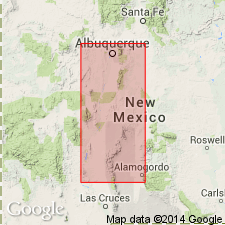
- Usage in publication:
-
- Apodaca formation
- Modifications:
-
- Original reference
- Dominant lithology:
-
- Limestone
- Chert
- Shale
- Sandstone
- Siltstone
- AAPG geologic province:
-
- Orogrande basin
Summary:
Pg. 27 (table 2), 31 (fig. 2), 32, 34, 36. Apodaca formation. Name applied to top formation of Green Canyon group. Consists of dense gray limestone with masses and lenses of chert, nodular limestone, calcareous shales, black to dark-gray calcareous siltstones, and greenish- to bluish-gray shales. Thickness increases from about 55 feet at type locality [text; 65 feet, measured section] to over 150 feet in southern part of state where formation consists of essentially pure limestone. Underlies Hot Springs formation (new); overlies the Arrey formation (new). Fossils (invertebrates, calcareous algae, fusulinids). Age is Pennsylvanian (Derry).
Type section: on west-facing slope of hill, about 0.8 mi east of village of Derry, in sec. 32, T. 17 S., R. 4 W., Sierra Co., central NM. Named from Apodaca Creek, a west tributary of the Rio Grande, 2.7 mi north by west of Derry, Sierra Co., central NM.
Source: US geologic names lexicon (USGS Bull. 1200, p. 117); supplemental information from GNU records (USGS DDS-6; Denver GNULEX).
For more information, please contact Nancy Stamm, Geologic Names Committee Secretary.
Asterisk (*) indicates published by U.S. Geological Survey authors.
"No current usage" (†) implies that a name has been abandoned or has fallen into disuse. Former usage and, if known, replacement name given in parentheses ( ).
Slash (/) indicates name conflicts with nomenclatural guidelines (CSN, 1933; ACSN, 1961, 1970; NACSN, 1983, 2005, 2021). May be explained within brackets ([ ]).

